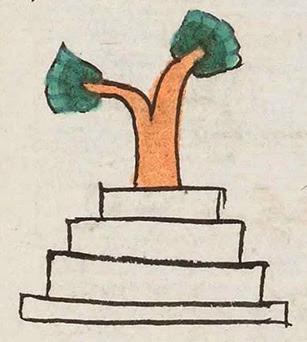Cuauhtetelco (Mdz48r)
This compound glyph for the place name Cuauhtetelco includes two principal elements, a tree (cuahuitl, whose stem is cuauh-, and a stepped pyramid building, or temple (tetelli). The tree is fairly standard except it only has two branches. The foliage is the typical two-toned green, and the trunk is a terracotta color. The temple consists of four white rectangles (drawn in black ink). The bottom one is the widest but also not very high. The next three levels, going up, get consistently less wide, creating a stepped pyramid. The -co locative is not represented visually in a specific way, but it may be represented semantically by the landscape features of the compound.
Stephanie Wood
Frances Karttunen suggests that the stem tetel- refers to a "mound, craggy land, sierra (cf. Tetela, Tetelcingo; vowel length and presence/absence of saltillo unknown)." It make sense if the place name refers to landscape feathers such as wooded, craggy land.
Berdan and Anawalt interpret this place as "Tree on the Mound," taking tetelli to mean mound. They also relate how Peñafiel (1885, 95) suggests "On the Wooden Temple," having cuahuitl refer to wood and tetelli to pyramid.
Tetelli is one of a few Nahuatl words for what Europeans would call pyramids, and this glyph may give insight into Nahua thinking about such structures. Another term that has been translated as pyramid is tzacualli, which is a word that has been used to describe the pyramids of the "sun" and "moon" at Teotihuacan, such as we see in the Primeros Memoriales ("ytzacual tonatiuh" and "ytztacual metztli") and in a slightly different version of the Florentine Codex, Book 7, Chapter 2 (in the corresponding place of the Memoriales), "tetepe tzacualli, ytzacual tonatiuh yoan ytztacual metztli." This latter use suggests that pyramids were seen as a type of tepetl, which is also echoed in later colonial Nahua manuscripts. The so-called Techialoyan manuscripts from ca. 1700, is where one will find "tlachihualtepetl," or a tepetl that is a "made thing" (tlachihualli), as in human-made. For other pyramid-like constructions in the Codex Mendoza, see glyphs that involve -teopan- and -teocal-, such as Capolteopan, Cihuateopan;
Teocalhueiacan, and
Teocaltzinco.
Of course, here, the pyramid may have been drawn to elicit the phonetic tetel- meaning mound. Thus, it may not be a literal reading. The reading of "mound" may be behind Karttunen's translation, "wooded upland."
Stephanie Wood
quauhtetelco. puo
Cuauhtetelco, pueblo
Stephanie Wood
c. 1541, but by 1553 at the latest
Stephanie Wood
pyramids, pirámides, construcciones, trees, árboles, mounds, monte, montículos, colinas, Quauhtetelco, pirámide, pyramid, nombres de lugares

cuahui(tl), tree, https://nahuatl.wired-humanities.org/content/cuahuitl-1
tetel(li), mound or pyramid, https://nahuatl.wired-humanities.org/content/tetelli
-co (locative suffix), https://nahuatl.wired-humanities.org/content/co
"Wooded Upland" [Frances Karttunen, unpublished manuscript, used here with her permission.]
"Tree on the Mound" (Berdan and Anawalt, 1992, vol. 1, 202)
"Tierras Altas Boscosas" o "Pirámide en el Monte"
Stephanie Wood
Codex Mendoza, folio 48 recto, https://digital.bodleian.ox.ac.uk/objects/2fea788e-2aa2-4f08-b6d9-648c00..., image 106 of 188.
The Bodleian Libraries, University of Oxford, hold the original manuscript, the MS. Arch. Selden. A. 1. This image is published here under the UK Creative Commons, “Attribution-NonCommercial-ShareAlike 3.0 License” (CC-BY-NC-SA 3.0).



